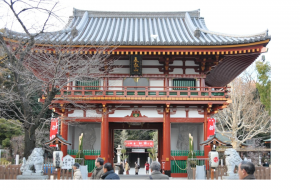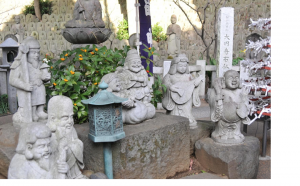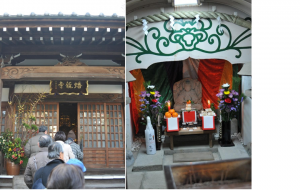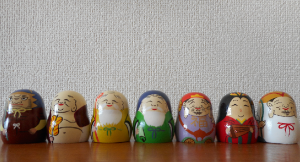白金台駅→覚林寺(毘沙門天)→瑞聖寺:(布袋尊)→妙円寺:(福禄寿、寿老人)→大円寺:(大黒天)→蟠竜寺:(弁財天)→滝泉寺:(恵比寿)
妙円寺に福禄寿と寿老人がいらっしゃるので、全部で6か所を巡ります。
白金台駅から元祖山手七福神巡りをスタートします。
元祖山手七福神では、目黒区の寺院から港区の寺院を巡るコースだと「商売繁盛祈願」、港区の寺院から目黒区の寺院を巡るコースだと「無病息災・長寿祈願」のご利益があるそうです。「無病息災・長寿祈願」のご利益を頂きたいので、港区の寺院から巡るコースを選びました。
第7回七福神巡りも脱落(途中棄権)者も故障(筋肉痛を訴える)者もなく、無事に終わりました。寺から寺への移動は徒歩10分ですが、道すがら日頃の生活の様子を互いに話し合いながら和気藹藹と時間の過ぎるのを皆で共有して楽しみました。 編集子:藤井 衞
今回、参加した白子俊比古 さんが、英文にて紀行文を書いてくださいました。どうぞ、そこからも七福神巡りの醍醐味を味わってください。次に掲載します。
Gannso Yamate Seven Lucky Gods Walk
Many Japanese people go to shrines and/or temples during first three days of New Year in order to celebrate the coming year and pray good fortune for them or their families. These visits are considered formal ones and visiting places are usually big and famous or visitors’ local ones. In addition to those formal visits, not a few people also enjoy so called small pilgrimage of the Seven Gods of Good Fortune as relaxation and recreation.
It is said the custom of the pilgrimage begun in the end of Muromachi period (the middle of 16th century) and became one of pleasure events among common people in Edo era. There was an old proverb on the number seven: ‘after seven misfortunes disappearing, seven lucks instantly coming’. And so seven deities were gathered and designated as ‘the Seven Lucky Gods’. The seven deities consist of three Indian origin gods, three Chinese and one Japanese god; I don’t know why and how these multi countries origins were selected.
The Seven Gods are as follows;
Bishamonten : the god of war and warriors (Indian origin : Hindu god Kubera)
Daikokuten : the god of wealth, farmers and the kitchen (Indian origin : Hindu god Mahakala, the reincarnation of Siva ).
Benten (or Benzaiten) : the goddess of music and fine arts and the only female deity (Indian origin : Hindu goddess Saraswati)
Hotei : the god of happiness and contentment (Chinese origin : Zen Buddhist in Tang Dynasty )
Jurojin : the deity of longevity (Chinese origin : with long white beard)
Fukurokuju : the deity of fortune, happiness and longevity (Chinese origin)
Ebisu : the god of commerce, fishermen and good fortune (Japanese origin)
The Gannso Yamate Seven Lucky Gods is the oldest course in Tokyo and spreads
from highland Shiroganedai to riverside Meguro. The pilgrimage route was
developed as the approach to Meguro Fudoson (the god of fire) Temple
which is located at the south-west (back demon gate direction : urakimon)
from Edo Castle.
In the afternoon of the sixth of January, 2017, sixteen men and women,
alumni and alumnae of Kwanseigakuin Univ., gathered at Shiroganedai
station of subway Nanboku Line. This year’s Seven Lucky Gods walk was
the seventh organized by one of alumnae Toshiko Nishikawa and taking the
very same route as the first excursion.
We first visited Kakurinji Temple which belongs to Nichiren sect and
enshrines Kato Kiyoasa , a great warrior in Japans’ civil war era, in the
main hall. And at the small shrine in the temple yard we worshipped
Bishamonten.
The second god Hotei seated at the right of main Buddha statue in the
main hall of Zuishoji (Zen temple of Obaku denomination). He is black and
fat with round belly which gives us very familiar and amicable impression.
Hotei is believed to be the reincarnation of Miroku Bosatu (Maitreya Bodhisattva) in China and Taiwan. But we Japanese image Miroku Bosatu lean and thin because of our acquaintance of the Miroku at Koryuuji Temple, Kyoto, and Chuguji, Nara. This gap of recognition between there and here surprises and interests us.
Two deities, Jurojin and Fukurokuju, are standing at Myoenji Temple which belongs to Nichiren sect and is introduced as one of renowned temple by ‘Edo Meisho Zue (a guide book on the famous places in Edo)’ published in the end of Edo period. They are both deities of Taoism and confused very often which is which. According to my recognition, Fukurokuju has a long gourd/peanut shell shape head and Jurojin has a round face with white beard. But in the dim light at the hall I could not identify the difference between the two.
Walking past JR Meguro station and descending the slope from Shiroganedai highland to the Meguro River along Gyonin-zaka lane there is Daienji Temple in the middle of the road. The temple is known where a fair girl Yaoyaohichi and an apprentice priest Saiun met and fell in love on the day of the great fire in Edo in 1772. In the yard of the temple there are many figures and statues including Daikokuten, Ohichi Jizo Bodhisatva (guardian deity of children) etc. The each temple of Yamate Seven Lucky Gods sells its own image small ornament whose shape looks like Dharma doll or Russian matreshka. People pick out an inlaid omikuji (sacred lot) from the ornament to read their fortune of this year.
People cross the Megro River, famous for cherry blossom in spring, and reach at Banryuji Temple to warship Benten. In the small shrine to the right of the main hall and near a pond Benten sits on the pedestal. Although Benten generally holds Biwa lute, but this Benten does not have the instrument. (That a porcelain figure, mimicking her image, next to her has a lute seems to show her be Benten even without holding a lute.) This temple has also the other Benten stature in a cave.
The last god Ebisu is enshrined at the annex building of Ryusenji Temple, also known as Megurofudoson, which was originally founded by revere Buddhist priest Ennin in Heian period and has been respected by many samurai warriors and common people through ages. The Ebisu has a fishing rod with his right hand and a big sea bream with his left and his chubby body give us friendly and lovable feeling.
We all members after completed the Seven Gods visit contented fully and believed this year’s our fortune be immersed in giant luck saying goodbye until the next Seven Gods pilgrimage in the next year.








